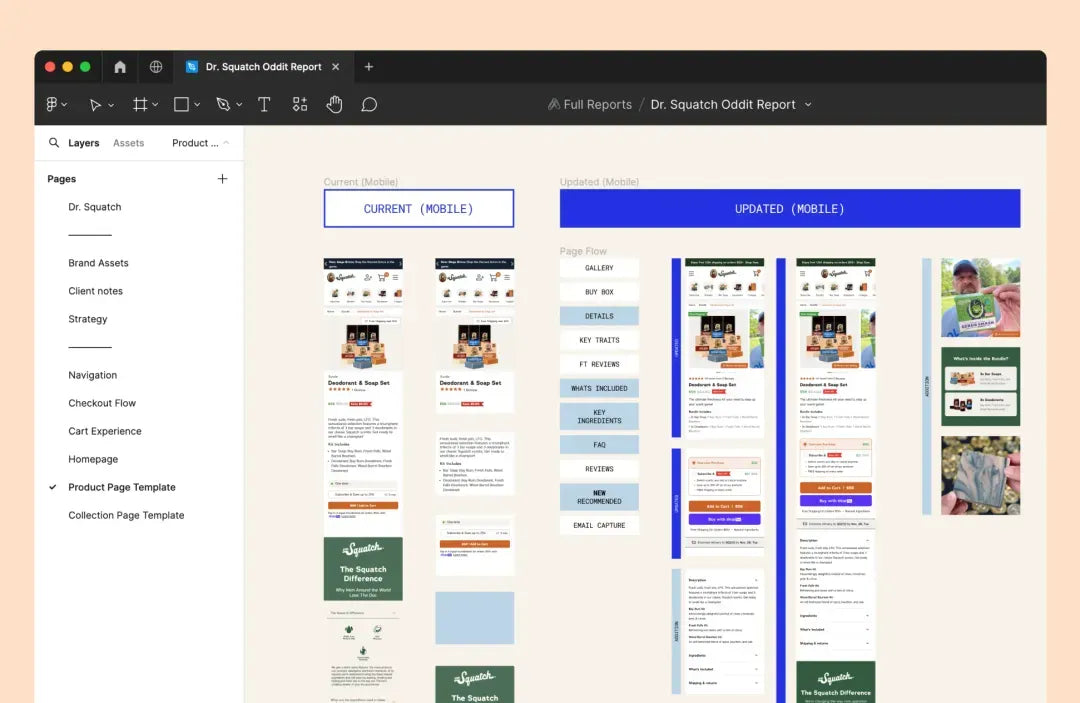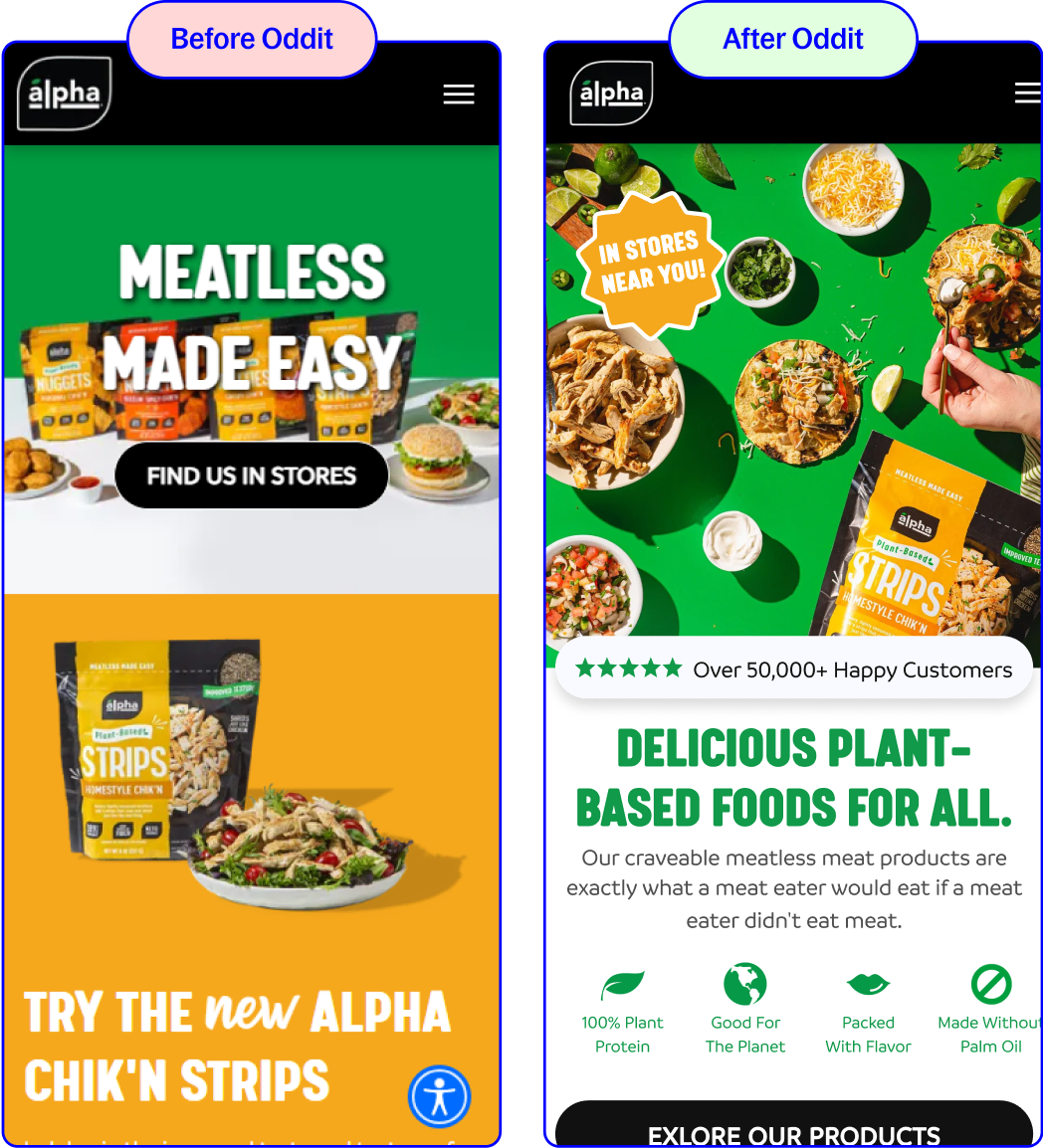Conversion Design & UX Reports
Analysis and conversion redesign of your website's most important ‘conversion critical’ elements.


Fast, Free Delivery
Of course it’s fast, we don’t have meetings. Of course shipping is free, we use email.
Dev-Ready Designs
Every asset, section, and layout built in Figma and battle-tested by thousands of developers.
No Retainers, No Contracts
Zero commitment, only what you need. You can always come back for seconds.



How Oddit Reports Work
Choose a Report
Fast, Simple Kick-Off
Delivery In Under 4 Weeks
Pricing & Packages
Order an Oddit
Whatever you sell online, our full-stack conversion experts will find your website's key conversion issues and provide ready-to-implement designs to fix them.
Oddit Essential
$2,250
x10 Redesigned sections
Our team reviews the pages submitted in your order and selects 10 sections to redesign for conversion. Usually this includes your cart and navigation as 2 of the sections as these are critical. A section is essentially a piece of your site you can see in a single view (ex. PDP Buy Box)
x10 Redesigned sections
25+ Page Oddit Report
Every design change is detailed with clear rationale in our clear and thorough report. Our reports not only help get your team aligned on the changes, but also act as an educational tool internally.
25+ Page Oddit Report
Navigation and Slide-in Cart Redesign
Your cart and navigation are the start and end point of the customer experience, making the critical for conversion. We optimize the design, information hierarchy, and ensure the right elements are in the right spot for highest click-through.
Navigation & Slide-in Cart Redesign
Mobile and Desktop Design in Figma
We send you all your new designs in an organized Figma file. Pass them off to a developer, or use as a starting point for future page designs.
Designed for both Mobile and Desktop
Top-Level Copy Review
As part of the design process we also review and edit any necessary top-level copywriting on site. This includes headlines, sub-headings, and button labels – anything that will have an effect on conversion!
Top-Level Copy Review
PLUS
Net New Section Designs
If something critical is missing from your site, our team will design a new section from scratch and add it to the page.
Net New Section Designs
Oddit Pro
$1,750+
Redesign and optimization of selected pages
Our team reviews the pages purchased in your order and redesigns them for conversion from top to bottom – no stone left unturned.
Redesign and optimization of selected pages
Navigation and Slide-in Cart Redesign
Every design change is detailed with clear rationale in our clear and thorough report. Our reports not only help get your team aligned on the changes, but also act as an educational tool internally.
50+ Page Oddit Report
Navigation and Slide-in Cart Redesign
Your cart and navigation are the start and end point of the customer experience, making the critical for conversion. We optimize the design, information hierarchy, and ensure the right elements are in the right spot for highest click-through.
Navigation & Slide-in Cart Redesign
Mobile and Desktop Design in Figma
We send you all your new designs in an organized Figma file. Pass them off to a developer, or use as a starting point for future page designs.
Designed for both Mobile and Desktop
PLUS
Page Flow Optimization
In addition to redesigning your pages, our team also optimizes the page flow of your purchased pages. We ensure the flow of information is presenting the most critical content first, and telling the customer a clear story to optimize conversion.
Page Flow Optimization
Net New Section Designs
If something critical is missing from your site, our team will design a new section from scratch and add it to the page.
Net New Section Designs



Looking for something more custom? Book a Discovery Call
Which Oddit is Right for Me?
Oddit Essential
Perfect for those seeking quality design & UX improvements on a more focused level (10 sections across 1-2 URLs). Great for budget conscious brands who would see significant lift by helping a single offering stand out.
- For businesses just starting to A/B test
- For single-SKU brands and products
- For smaller websites (5-10 pages)
Oddit Pro
Built for those looking to optimize multiple on-site journeys. The Oddit Pro ensures every detail is optimized to help you deliver a cohesive user experience and lower those acquisition costs. The Oddit Pro is perfect for sites that house a lot of information, products, or pages.
- For businesses who A/B test on the regular
- For websites with multiple products & journeys
- For medium-large websites (10-100 pages)
What We’re Especially Good At

“Above the Fold” Hyperfocus

Easy-to-understand Rationales

A/B Testing Ideas

Before & After Mockups

Improved Navigation & Cart

Brand Consistency Clean Up
Get a Free Oddit Design!
Get a taste of the Oddit experience with a FREE redesigned section from any page of your website or product. No credit card required.

What’s a Section?
Think of a section like a slice of a page, containing specific content & functionality–like a product card or reviews section.
Collapsible content
What kind of conversion results can I expect?
The conversion results from implementing your Oddit recommendations depend on a variety of factors. Quality of traffic, ad campaigns, and development quality are just a few of the factors that play into it. While we don't ever guarantee specific results, Oddit has a 99.9% satisfaction rating across our thousands of customers.
From a data perspective, we've seen everything from a 5% lift in conversion (ex. 3% CVR increased to 3.15%), to select customers 3x'ing their conversion (ex. 2% CVR increased to 6%).
What if I need help with development?
We have an amazing in-house development team that have helped hundreds of Oddit customers bring their designs to life as intended. But our Oddit report and landing page design engagements do not include development outright, it is a separate scope. Learn more here or book a call with our team right here.
If you're looking for a more full-service engagement, you can also book a call with our Oddit Service division where you can get everything from strategy sessions, to ground-up website design & builds.
To learn more book a call with our team right here.
Do you build websites from scratch?
Yes! We approach full-site design & builds with the same brand-first CRO lens, just with a slightly more intimate & deeper partnership. If you're interested in a full-site build or other custom engagement, book a call with our Head of Oddit Service, Cameron,right here.
What Shopify Theme does Oddit recommend?
We have a very high bar when it comes to e-commerce. After working with hundreds of theme's we were yet to find one that truly checked all the boxes.
Can I add more pages to my Oddit later?
You sure can! If you're happy with your initial Oddit Report, there are numerous ways to keep the fun going.
1. If you're anOddit Essentialcustomer, you can upgrade to any Oddit Pro package, and we'll subtract the cost of your Essential report from the price.
2. If you're anOddit Procustomer, you can add more pages at any time in the future and you simply pay the cost of the additional pages. Simplyreach out to our customer serviceteam when you're ready!
3. If you're ready dive into the deep end with the Oddit team, you canbook a strategy callwith our Oddit Service team to discuss more custom or in-depth engagements.
Which Oddit Report is best for me?
All of our reports are packed with value, and you can add pages or new elements anytime. However, if you need help determining which package is best suited to your site, book a call with our leadership for a free 30-minute assessment. Feel free to grab a timeright here.
Do you support multiple languages?
While our team is primarily English speaking, we've Oddited sites in over 50 countries and many languages. Our team uses translation tools to Oddit the site experience and copywriting in English and deliver back everything for your team. The design files and Oddit report will be delivered in English.
How does Oddit Report pricing work?
There are two different pricing tiers for our Oddit Reports.
1. OurOddit Essential Reportis a set fee of $2,250. The Essential report is ideal for customers wanting a variety of conversion design ideas across a few areas of their site, or want a single page reviewed.
2. OurOddit Pro Reportis $1750 per page (minimum 2 pages) for analysis and redesign. Additional pages can be added at any time!
Is there copywriting included in my Oddit Report?
There sure is! As part of our conversion analysis, our team will review everything from product titles and button labels, to headlines and other key content. While we provide lots of copy edits in our review, we do not rewrite long-winded fine print such as shipping terms, policies, or about page blurbs for instance.
If it doesn't directly effect conversion, we don't touch it.
Can you Oddit my design files?
Absolutely! While the majority of our customers have us Oddit their live website, Odditing design files is one of the most effective approaches to take, as things only need to be developed once rather than rebuilt.









